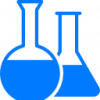Blackening is among most common ways of steel colouring for both decoration and, to a lesser extent, anticorrosion protection (optical appliances, hunting arms, fancy-goods). A very thin coating is formed by a mixture of both ferric and ferrous oxides of dark blue-to-genuine black colour. A perfect blackened finish of high gloss may be merely achieved if the steel substrate is machined as much fine as possible. The steel parts for blackening must be cleaned for the pure metal appearance, free of any rust, mill scales and grease which otherwise might result in colour imperfections and spots in the coating formed. Due to a very low thickness, the blackening coating will copy all defects (mars, scratches, local roughness) on the substrate surface which thus should be avoided. For a glossy finish of the utmost quality, the steel parts to be blackened should be polished (e.g. barrel-polished) at first. On the other hand, a matt finish may be achieved through a slight roughening of the substrate. To enhance both corrosion performance and mechanical durability of the blackening coatings, a subsequent passivation with the agents containing adsorption-based corrosion inhibitors is strongly recommended. For further increase in the performance, an impregnation of the blackening with oil-based preservatives for temporary corrosion protection, after its drying out, is advisable which, moreover, will emphasize the black tone of the coating. If the drying operation of the blackened coating is not possible to be included in the line, the preservation with oil-based water-removers containing adsorption corrosion inhibitors should be preferred. As a principle, only plain carbon steels may be blackened in superior quality and the steels of a higher silicone content should be pickled with 10 % hydrofluoric acid at first.
Pragokor Brunigal S
alkaline blackening agent of high performance for the parts made of carbon steel
A very efficient agent for alkaline blackening of steel parts. The coating deposited features very good durability against wear and is of superior decorative finish and deep black tone.
Pragokor Brunigal S should be used in the concentration of 80 kg per every 100 litres of the bath. The respective amount of the agent should be at first dissolved in the container half-filled up with water and, after the complete dissolution, replenished with water for the running volume and finally heated up for the operating temperature 135 - 145 °C, the operation time being 5 – 15 minutes according to the composition of the steel to be treated and required coating appearance. The water evaporated during operation must be continuously refilled. In case of a decline of the bath performance, the agent should be stepwise dosed carefully, the overall amount of which being governed by the demanded bath temperature – at a low bath concentration the bath boiling point drops below 135 °C. Owing to the possibility of hot bath splashing, the necessary safety precautions must be strictly observed. The bath pollution with copper (introduced e.g. from the parts made of copper or its alloys) must be avoided as, at the copper concentration as low as 5 mg/litre, a non-uniform colour of the blackening might occur.
Pragokor Brunigal N
versatile blackening salt with anticorrosion performance for the parts made of both carbon as well as alloy steels
It is a more versatile blackening salt for the treatment of carbon as well as alloyed steel parts, suitable for blackening of cold-drawn, cold-rolled and heat-treated steel parts and for cast iron as well. Furthermore, as for the copper plated coatings after cold-drawing operations, copper-based solders and, under certain conditions, silver, a dark colouring may be achieved. The running bath should be prepared by the dissolution of the agent in water in the weight ratio 1 : 1. The heated container should be at first filled up with water for half of its volume and then the calculated amount of Brunigal N step-by-step dissolved. The freshly prepared bath is of colourless-to-yellowish colour and as late as at running is gradually acquiring a brown tone. The boiling point of the fresh bath is 138 °C, the running temperature of which ranging within 135 - 148 °C and the operating time 5 – 15 minutes.
Properties of the blackening coating:
- black colour
- thickness 0,5 - 1,5 um
- specific weight-per-area unit value 7,5 g/m2
In comparison with common blackening baths, the Pragokor Brunigal N bath features:
- The bath surface is free of any foam and, even without a foam cover, undesirable bath splashing as well.
- The viscosity of the blackening bath is very low (close to that of water) which, consequently, cuts down the bath drag-out by 30 % if compared with the common blackening agents. The decline in pollution of the subsequent rinse water with the salts transferred from the running bath, therefore, results in a reduced demand for rinse water.
- The blackening coating is highly compact even at an enhanced thickness and of a very decorative deep black tone.
- Excellent durability against wear and increased anticorrosion performance.
- The corrosion inhibitors contained in the Brunigal N agent will cause a reduced bath sludge formation and, therefore, are able to preserve the original gloss of the blackening while a restrained sludge formation accounts for reduced cost for waste water disposal.
- High bath concentration enables the start-up of the bath to be realized in the agent/water ratio 1 : 1 by weight optimally.
- The blackening process in the Brunigal N bath is less susceptible to fluctuations in bath concentrations than the common baths.
- At normal running conditions, the lifetime of the bath is supposed for several years.
- At an enhanced bath loading, both bath regeneration and occasional sludge removal are recommended.
- The Brunigal N agent is optimally suitable for the closed circuits, i.e. for the blackening lines with 100% recycling of rinse water, however, the excellent water utilization may be even achieved in the common technological lines with flowing-through rinses.

